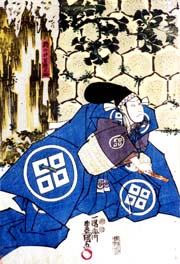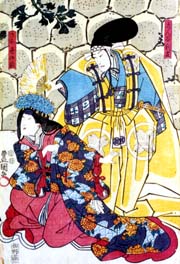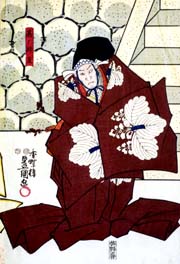| DAIJO |
| Play title | Kanadehon Chűshingura |
| Authors | Takeda Izumo II Miyoshi Sh˘raku Namiki Senryű I |
| History |
The play "Kanadehon Chűshingura" was originally written for the puppet theater (Bunraku) and staged for the first time in the 8th lunar month of 1748 in ďsaka at the Takemotoza. It was adapted for Kabuki the same year and staged for the first time in the 12th lunar month of 1748 in ďsaka at the Kado no Shibai [casting]. The "Daijo" act was performed with the actors Ichimura Mihoemon, Yamamoto Koheiji and Ichinokawa Hikoshir˘ II in the roles of Moron˘, Momonoi Wakasanosuke and Hen'ya Hangan. |
| Structure |
The "Kabuto Aratame" act, the first act of "Kanadehon Chűshingura", commonly called daijo (literally 'the prologue'), is always performed for a t˘shi ky˘gen production of this drama and is never staged independently of the others acts. |
| Key words |
Adauchi Adauchimono Ashikaga Tadayoshi Daijo Daimy˘ Gidayű Ky˘gen Godaigo Tenn˘ Hippari no Mie Jidaimono Kabuki Sandai Meisaku Ky˘gen Shijűshichishi |
| Summary |
Act I: Kabuto Aratame This first act, commonly known as "Daijo", ("the prologue"), is one of extreme stylisation. At the very beginning the curtain is pulled aside very slowly and with great solemnity, while the piercing sound of the clappers is heard exactly 47 times before it is fully open. Each click represents one of the 47 r˘nin. After this, a voice calls out "T˘zai, t˘zai", a phrase literally meaning "east, west", but used here to call the audience's attention rather like the English "hear ye, hear ye". The phrase is called out 7 times on the left, 5 times in the centre and 3 times on the right before the actors move. This 7-5-3 combination is auspicious. Meanwhile, the Gidayu shamisen enters, followed by a chanter who sets the mood. All this time the actors are seated motionless like lifeless puppets and it is only when the chanter mentions their names in turn that they "come to life". We can tell each character's type by the colour of his robes and by the manner in which he moves, so that the evil governor of Kamakura, K˘ no Moron˘ is dressed in black and makes 7 abrupt jerks of his arms as he awakens. The impulsive young lord Wakasanosuke is dressed in pale blue and makes several strong movements of his head as he lifts it, while Enya Hangan is in yellow and his calm temperament is indicated by his smooth fluidity. The act takes place within the precincts of the Tsurugaoka Shrine in Kamakura. The Sh˘gun's younger brother, Ashikaga Tadayoshi has come to the shrine today to oversee a dedication ceremony and he is accompanied by many daimy˘, ("feudal lords"), of whom the most senior is Moron˘. Their business is to enshrine an important helmet that once belonged to the emperor Godaigo, but before that, that particular helmet must be identified from among the many that were found on the battlefield. The only one who has previous experience of the helmet and therefore the only one who can identify it now is Hangan's wife, Lady Kaoyo. She is summoned and proceeds to inspect several helmets which are presented to her. At last, she identifies the correct helmet and is officially dismissed. Tadayoshi, accompanied by Hangan, Wakasanosuke and all the other lords then take the helmet into the shrine for its dedication. But Moron˘ stays behind. He is a lecherous character and has been attracted to Kaoyo for some time. He finds an excuse to hand her a love letter which she, filled with disgust and embarassment, drops on the floor. She is only saved from his further advances by the reappearance of Wakasanosuke who instructs her to leave at once. In Moron˘'s eyes, the rash and impudent Wakasanosuke has already angered him by disagreeing with him earlier in the act, but now this new interference of his in Moron˘'s private affairs is going a step too far. Moron˘ begins to insult Wakasanosuke who quickly becomes furious and is about to throw caution to the winds and attack the senior lord when Tadayoshi returns. Wakasanosuke must now put off his revenge. The act ends with a magnificent mie pose of the type called hippari no mie, the "pulling apart pose", which symbolizes the mutual animosity of the two men. Courtesy of Paul M. Griffith Next scene: "Rikiya J˘shi" |
| Comments |
One suspects that the character of Moron˘ is actually quite fun to play for an actor. The role is not particularly deep: he is a pure villain with no redeeming features whatsoever, and yet he dominates this first, and the third acts totally. His particular brand of evil shows itself not only in his licenscious nature, but also in a cruel and sadistic streak that will not let up until Moron˘ is satisfied that he's done maximum damage. He really does seem quite frightening. The character of Wakasanosuke makes an easy target for Moron˘'s vicious taunts, for as an inexperienced lord with an impulsive nature, he is only too ready to rise to Moron˘'s bait. Courtesy of Paul M. Griffith |
 |
 |
 |
|
Sawamura Ch˘jűr˘ V, Iwai Kumesabur˘ III, Onoe Shinshichi III and Band˘ Mitsugor˘ IV playing the roles of Momonoi Wakasanosuke, Kaoyo Gozen, En'ya Hangan and K˘ no Moron˘ in the drama "Kanadehon Chűshingura", which was staged in the 7th lunar month of 1849 at the Nakamuraza (print made by Utagawa Toyokuni III) |
||
|
|
| Contact | Main | Top | Updates | Actors | Plays | Playwrights | Programs | Links | FAQ | Glossary | Chronology | Illustrations | Prints | Characters | Derivatives | Theaters | Coming soon | News |